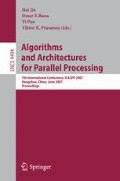Abstract
Incremental computing masks the communication latency by overlapping computations with communications. However, a sequence of messages with a large latency variance still makes computations proceed intermittently. It is known that a dominant input stream from a data server maximizes the CPU utilization of the networked computation server [7]. Unfortunately, the problem of finding a dominant input stream is \(\mathcal{N}\mathcal{P}\)-hard in the strong sense. In this paper, a dominant input stream for LU decomposition is proposed. It is shown that the dominant input stream outperforms the input stream sending data in traditional order. In addition, the nonexistence of dominant input streams is proved for the case that the compressed format is used for sending input data.
This research is partially supported by National Science Council under the grant 95-2221-E-197-013.
Access this chapter
Tax calculation will be finalised at checkout
Purchases are for personal use only
Preview
Unable to display preview. Download preview PDF.
References
Bhat, P.B., Prasanna, V.K., Raghavendra, C.S.: Efficient Collective Communication in Distributed Heterogeneous Systems. J. Parallel and Distributed Computing 63(3), 251–263 (2003)
Cormen, T.H., Leiserson, C.E., Rivest, R.E., Stein, C.: Introduction to Algorithms, 2nd edn. MIT Press, Cambridge (2002)
Foster, I., Kesselman, C., Tuecke, S.: The Anatomy of the Grid: Enabling Scalable Virtual Organizations. Int’l J. Supercomputer Applications 15(3), 200–222 (2001)
Hsu, C.H., Chung, Y.C., Yang, D.L., Dow, C.R.: A Generalized Processor Mapping Technique for Array Redistribution. IEEE Trans. on Parallel and Distributed Systems 12(7), 743–757 (2001)
Kalns, E.T., Ni, L.M.: Processor Mapping Techniques Toward Efficient Data Redistribution. IEEE Trans. Parallel Distrib. Systems 6(12), 1234–1247 (1995)
Lin, C.C.: Strategies for Achieving High Performance Incremental Computing on a Network Environment. In: Proc. the 17th Int’l Conf. Advanced Information Networking and Applications, pp. 113–118 (2004)
Lin, C.C., Hsu, T.S., Wang, D.W.: Bounds on the Client-Server Incremental Computing. IEICE Trans. Fundamentals of Electronics, Communications and Computer Sciences E89-A(5), 1198–1206 (2006)
Liu, P.: Broadcast Scheduling Optimization for Heterogeneous Cluster Systems. J. Algorithms 42(1), 135–152 (2002)
Ranka, S., Shankar, R. V., Alsabti, K. A.: Many-to-Many Personalized Communication with Bounded Traffic. In: Proc. Symp. the Frontiers of Massively Parallel Computation, pp. 20–27 (1995)
Shyamasundar, R.K., Rajan, B., Prasad, M., Jain, A.: LLM A Low Latency Messaging Infrasture for Linux Cluster. In: Sahni, S.K., Prasanna, V.K., Shukla, U. (eds.) HiPC 2002. LNCS, vol. 2552, pp. 112–123. Springer, Heidelberg (2002)
Strumpen, V.: Software-Based Communication Latency Hiding for Commodity Workstation Networks. In: Proc. Int’l Conf. Parallel Processing, pp. 12–16 (1996)
Strumpen, V., Casavant, T. L.: Exploiting Communication Latency Hiding for Parallel Network Computing: Model and Analysis. In: Proc. Int’l Conf. Parallel and Distributed Systems, pp. 622–627 (1994)
Wang, C.L., Prasanna, V.K., Kim, H.J., Khokhar, A.A.: Scalable Data Parallel Implementations of Object Recognition using Geometric Hashing. J. Parallel and Distributed Computing 21(1), 96–109 (1994)
Yu, C.W., Hsu, C.H., Yu, K.M., Liang, C.K., Chen, C.I.: Irregular Redistribution Scheduling by Partitioning Messages. In: Srikanthan, T., Xue, J., Chang, C.-H. (eds.) ACSAC 2005. LNCS, vol. 3740, pp. 295–309. Springer, Heidelberg (2005)
Author information
Authors and Affiliations
Editor information
Rights and permissions
Copyright information
© 2007 Springer-Verlag Berlin Heidelberg
About this paper
Cite this paper
Lin, CC. (2007). A Dominant Input Stream for LUD Incremental Computing on a Contention Network. In: Jin, H., Rana, O.F., Pan, Y., Prasanna, V.K. (eds) Algorithms and Architectures for Parallel Processing. ICA3PP 2007. Lecture Notes in Computer Science, vol 4494. Springer, Berlin, Heidelberg. https://doi.org/10.1007/978-3-540-72905-1_36
Download citation
DOI: https://doi.org/10.1007/978-3-540-72905-1_36
Publisher Name: Springer, Berlin, Heidelberg
Print ISBN: 978-3-540-72904-4
Online ISBN: 978-3-540-72905-1
eBook Packages: Computer ScienceComputer Science (R0)

